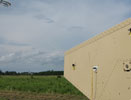

Airborne wind energy holds the promise of a more effective means of harnessing the power of the wind. AWE unleashes the blade, or wing, of a turbine from its fixed structure and allows it to fly. With flight comes the ability to sweep large areas of the sky to capture significantly more of the wind’s power. Windlift is one of the first companies to pursue this new technology.
The challenge
To provide portable renewable energy to remote villages and other areas where there is no access to the power grid. Remote villages without access to the grid must rely on diesel or petroleum generators for electricity, which means they have power only when they can get fuel.
The solution
To develop a portable 12 kW airborne wind energy system that uses a tethered, flexible airfoil to replace the blades and tower found on traditional wind turbines. Because the system has no tower, it does not require a heavy reinforced concrete foundation, so it can be mounted to a trailer and can provide portable renewable energy in remote off-grid areas.
System operation
The AWE technology uses a flexible airfoil to capture power from the wind. The airfoil is tethered to a base-station and the tethers are spooled onto a large drum. The system, which is mounted to a trailer, operates as a long-stroke reciprocating engine. During the generate phase of the cycle, the airfoil is actively flown in a cross-wind manner downwind of the base station, which maximises the tension in the tethers. As the airfoil moves away from the ground station, the tethers unspool from the drum and drive it to turn a motor/generator. Electrical power from the generator is transmitted to a battery bank that is also mounted to the trailer. When the maximum tether length is reached, the airfoil is ‘depowered’ (ie, oriented into the wind to minimise tether tension) and retracted. The net energy gain per cycle is the energy generated during the outgoing stroke minus the energy consumed during the retract stroke.
We control the system by using an AC motor/generator, two servo motors to steer the airfoil, and two stepper motors to operate the levelwind which stacks the tethers onto the drum. All of these devices interface with an NI CompactRIO embedded system through a CAN bus interface. Additionally, we use two analogue joysticks and a number of digital I/O to interface with the system. Currently, the AWE system is manually operated, but the plan is to automate for future designs.
In addition to the user controls and actuators, the CompactRIO also interfaces with sensors that monitor the horizontal and vertical angle of the airfoil with respect to the base station, the tension in the tethers, the amount of tether remaining on the drum, and the flow of power and charge state of the battery bank. Data from all of these sensors is used to control the cyclic operation and maximise generated power and stability.
From prototype to production with CompactRIO
We chose the CompactRIO platform for this project for several reasons. First, the seamless interface between the CompactRIO and the NI LabVIEW development environment offers a turnkey hardware/software solution with very little learning required.
Second, the wide availability of modules for the CompactRIO means that all of the varied sensors and protocols can be integrated with a single modular system (load cells, temperature sensors, fieldbus, analog, digital, and so on).
Third, the power and flexibility of the combined field-programmable gate array (FPGA) and real-time processor architecture offers functionality that would not be possible with either component alone.
Fourth, and perhaps most importantly, National Instruments illustrated a clear development pathway with the CompactRIO from prototype to production with the same hardware and software.
The FPGA backplane in the CompactRIO system was particularly useful in our development. The ability of the FPGA to run tasks in a parallel manner at high speed (40 MHz clock cycle) enabled us to offload time-critical tasks from the real-time processor. One example of a task that is well-suited to the FPGA is monitoring the proximity sensors that act as an incremental encoder to measure the drum’s rotation. A code segment running on the FPGA counts each sensor pulse at up to 800 pulses per second and communicates the incremental drum position to the realtime controller.
During this development, we used an NI Green Engineering Grant award for a seat of the NI Developer Suite, which included the LabVIEW real-time development environment, NI DIAdem data management and analysis software, LabVIEW FPGA, LabVIEW NI SoftMotion, LabVIEW control design and simulation modules and the LabVIEW PID and fuzzy logic toolkit.
One of the most useful tools for this project outside of the LabVIEW development environment was the DIAdem data analysis software. We used the shared variable engine feature of the CompactRIO to port data over a TCP/IP connection to a remote laptop for datalogging.
The large volume of data generated during the test program was invaluable to the design and development process. Each data file, which represents 10 minutes of operational time, is approximately 4 MB and contains almost 70 individual channels. DIAdem was perfect for processing and analysing this large volume of data. An additional functionality that proved invaluable was the ability to synchronise this with video of the system in operation.
We are currently in the final stages of testing the portable AWE system prototype. The CompactRIO embedded system has been a valuable asset during this development process and we anticipate that it will continue to be an integral part of the system. One important aspect of this approach is that the transition from the current manually operated system to an automated system will be streamlined, and will involve only a software update. This is possible because the manually operated system is fly-by-wire and the CompactRIO has the functionality and performance to replace the user in an automated system.

© Technews Publishing (Pty) Ltd | All Rights Reserved